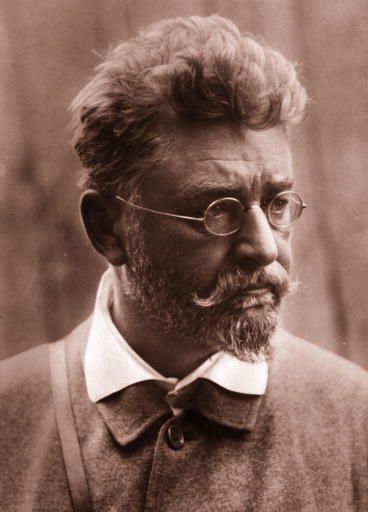<Back to Index>
- Mathematician Evert Willem Beth, 1908
- Writer Ludwig Ganghofer, 1855
- General of the U.S. Air Force Earle Everard "Pat" Partridge, 1900
PAGE SPONSOR

Ludwig Ganghofer (July 7, 1855 - July 24, 1920) was a German writer who became famous for his homeland novels.
Born in Kaufbeuren, he graduated from a gymnasium in 1873 and subsequently worked as a fitter in Augsburg engine works. In 1875, he entered Munich Polytechnic as a student of mechanical engineering, but eventually changed his major to history of literature and philosophy, which subjects he studied in Munich, Berlin and Leipzig. In 1879, he was awarded a doctorate from the University of Leipzig.
Ganghofer wrote his first play "Der Herrgottschnitzer von Ammergau" (The Crucifix Carver of Ammergau) in 1880 for the Munich Gärtnerplatz Theatre. It was so successful that it was performed 19 times. But his breakthrough was a guest performance of this play in Berlin, where it was staged more than 100 times. Subsequently, Ganghofer worked as dramaturge at the Vienna Ringtheatre (1881), as a freelance writer for the family paper Die Gartenlaube and as a feuilleton editor of the Wiener Tagblatt (1886 - 1891). Since 1891, he was working mainly as a writer of Alpine novels, inspired by the sojourns at his hunting lodge near Leutasch in Tyrol; but he also produced e.g. Hugo von Hofmannsthal's play "Der Tor und der Tod". He also founded the Munich Literary Society.
His work as a voluntary war correspondent from 1915 and 1917 is less known. During those years, he wrote - besides propagandistic and little impartial war reports e.g. the "Reise zur deutschen Front" (Travel to the German frontlines) - a large number of War poems, which were published in Anthologies like "Eiserne Zither" (Iron Zither) and "Neue Kriegslieder" (New War songs), displaying a nationalist and anti-democratic attitude. Being a personal friend of Emperor Wilhelm II, Ganghofer's war reports were frequently lauding the emperor and his way of conducting the war. Even until shortly before the German capitulation, he published calls not to give up fighting. Heavily criticised by colleagues like Karl Kraus, lectures of his war exalting oeuvres provided him an above average income.
After the end of the war, Ganghofer returned to his profession as a writer. He dedicated his last work "Das Land der Bayern in Farbenphotographie" (The country of Bavaria in coloured photography) to "His Majesty King Ludwig III of Bavaria in deepest reverence". Shortly after, Ganghofer died in Tegernsee.
Ganghofer's works, in particular his novels, are still published nowadays. By 2004, an estimated more than 30 million copies of his works were sold. Besides, Ganghofer is one of the German writers whose works were filmed utmost, especially during the Heimatfilm era after World War II. His homeland novels earned Ganghofer the reputation as a "world of good" writer. His works which describe the life of simple, competent, honest people are often seen as Kitsch - not at least because most of them are staged against the background of an idyllic Bavarian Alps scenery.
Ganghofer's brother-in-law was the geologist and geographer Albrecht Penck, his nephew the geomorphologist Walther Penck.